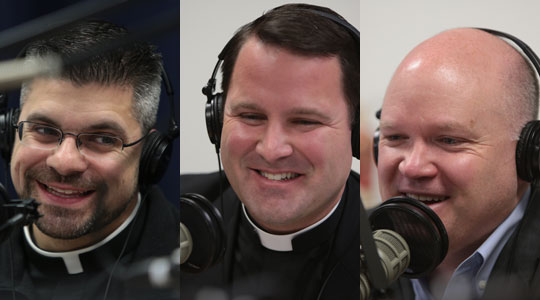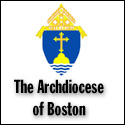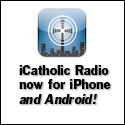Summary of today’s show: The Easter Vigil is the Super Bowl of liturgies in the Catholic Church calendar, with our most beautiful prayers and symbols and imagery, encapsulating all of Salvation History. For the first time this Easter, we will hear the prayers using the new translation of the Roman Missal, which restores the beautiful phrase lost over time. Fr. Jonathan Gaspar joins Scot Landry and Fr. Matt Williams to discuss the Easter Vigil and especially to chant the Exsultet, the Easter Proclamation, like you’ve never heard before.
Listen to the show:
Podcast: Play in new window | Download
Today’s host(s): Scot Landry and Fr. Matt Williams
Today’s guest(s): Fr. Jonathan Gaspar, Director of the Office for Divine Worship
Links from today’s show:
Today’s topics: The Easter Vigil Liturgy
1st segment: Scot and Fr. Matt discussed the topic for today’s show which will be the Super Bowl of liturgies, the Easter Vigil on Saturday evening. Fr. Jonathan Gaspar, the director of the Office for Worship will assist them with examining the Vigil Mass.
Fr. Matt will be very busy on Good Friday and Holy Saturday, starting in Nahant and engaging in many service projects with the Hunger for Justice retreat for high school students.
Fr. Matt said he has only been the main celebrant of the Easter Vigil liturgy once as a priest, because he’s either been a parochial vicar or head of the Office for the New Evangelization of Youth and Young Adults and it’s usually the pastor who celebrates.
Also, tonight is the last opportunity for The Light Is On For You, to go to confession in any parish or chapel in the archdiocese from 6:30-8pm.
Scot welcomed Fr. Jonathan to the show and said over the past year he;s been helping people adapt to the changes in the Roman Missal. Fr. Jonathan said all the texts of the Mass have changed and the Easter vigil is no different. He said the texture of the language is changed, phrases that were lost in the old translation have been restored, including language related to the work of Creation in preparing the liturgy./
Scot said the Mass is usually in two parts: Liturgy of the Word and Liturgy of the Eucharist. But the Easter Vigil is not just two parts. Fr. Jonathan said the Easter vigil is four parts: We begin with the Service of Light, the blessing of the fire in darkness outside of the church. This blazing fire scatters the darkness of night. This goes back to the second century and Eusebius refers to this in the fourth century, saying the Easter fire illuminated the city of Byzantium. The deacon or priest then proclaims the great praise of Easter.
Scot talked about taking small children to the Easter Vigil, how they will love seeing all the different aspects. He suggested sitting in the back to see the events surrounding the lighting of candles.
Then there is the Liturgy of the Word. There are seven readings from the Old Testament, which are the story of Salvation History, how the love f God for his people culminated in Easter; the Epistle from the New Testament; and the Gospel. Fr. Jonathan said it tells the story of how God remembers his covenant even when we have failed to love him. It tells the story of God calling us back each time, reestablishing his covenant. Finally the Father sends His Son to establish a new eternal covenant that will never be broken. Scot said you can’t walk away from the Vigil without being aware of God’s love for us.
The third part of the Vigil is also different. It’s the celebration of the sacraments of initiation for candidates and catechumens. During Lent they have been preparing through prayer and examination of themselves to receive these sacraments. They receive the sacraments of baptism, confirmation, and the Eucharist. This part also helps everyone renew their baptismal promises. In a beautiful way we relight our own candles. The water of the baptism is sprinkled upon the people, reminding us of the blood of the sacrifice of the lambs sprinkled over the people of Israel during the first Passover in Egypt. Scot said it also reminds us of our own baptism. Fr. Jonathan said a funeral liturgy is like a mini-Easter Vigil, from the way t he body is greeted at the door to the church and blessed and carried forward and clothed in baptismal gowns and the use of the paschal candle and more. Fr. Matt said the funeral is first and foremost a celebration of the paschal mystery of Christ.
The fourth part is the Liturgy of the Eucharist. Fr. Jonathan said every Mass is a celebration of the special meaning that the Eucharist has on Easter, receiving the risen body and blood of our Lord.
Fr. Jonathan said at the cathedral they have the blessing of the fire outside because the rubrics say it should be a roaring fire. Then they will hold a procession around the cathedral. CatholicTV will broadcast the Easter vigil.
Scot said the Mass always has to start after dark. Fr. Jonathan said this goes back to the 2nd century. In the 7th century they started creeping back the vigil to Saturday morning, but in 1951 the Vatican released a new text for the vigil that required that it take place after dark and finish before dawn. In the Archdiocese of Boston, parishes cannot begin until after 8pm. How can Christ cast out darkness if the sun is still shining. The symbolism speaks volumes when done in a dark church.
Fr. Jonathan said at the beginning of the Liturgy the priest blesses the fire. The fire represents purification, passion, and illumination. The first should represent our passion for evangelization.
Dear brethren (brothers and sisters),
on this most sacred night,
in which our Lord Jesus Christ
passed over from death to life,
the Church calls upon her sons and daughters,
scattered throughout the world,
to come together to watch and pray.
Ifwe keep the memorial
of the Lord’s paschal solemnity in this way,
listening to his word and celebrating his mysteries,
then we shall have the sure hope
of sharing his triumph over death
and living with him in God.Then the Priest blesses the fire, saying with hands extended:
Let us pray.
o God, who through your Son
bestowed upon the faithful the fire of your glory,
sanctify this new fire, we pray,
and grant that,
by these paschal celebrations,
we may be so inflamed with heavenly desires,
that with minds made pure
we may attain festivities of unending splendor.
Through Christ our Lord.
R. Amen.
They then bless the candle, and the priest inserts some Greek letters and the numbers of the year. The priest then puts five spikes of incense. Incense is part of sacrifice and the incense signifies that the candle itself burns in praise. The incense is inserted in a shape of cross, representing the wounds of Christ. The candles is a symbol of the resurrected and glorified body of Christ.
After the blessing of the new fire, one of the ministers brings the paschal candle to the Priest, who cuts a cross into the candle with a stylus. Then he makes the Greek letter Alpha above the cross, the letter Omega below, and the four numerals of the current year between the arms of the cross, saying meanwhile:
1. Christ yesterday and today (he cuts a vertical line);
2. the Beginning and the End (he cuts a horizontal line);
3. the Alpha (he cuts the letter Alpha above the vertical line);
4. and the Omega (he cuts the letter Omega below the vertical line).
5. All time belongs to him (he cuts the first numeral of the current year in the upper left comer of the cross);
6. and all the ages (he cuts the second numeral of the current year in the upper right comer of the cross).
7. To him be glory and power (he cuts the third numeral of the current year in the lower left comer of the cross);
8. through every age and for ever. Amen (he cuts the fourth numeral of the current year in the lower right comer of the cross).
[Insert inscription diagram for candle, cf. Missale Romanum, p. 339]When the cutting of the cross and of the other signs has been completed, the Priest may insert five grains of incense into the candle in the form of a cross, meanwhile saying:
- By his holy (Insert incense diagram for candle, cf. Missale Romanum, p. 339]
- and glorious wounds,
- may Christ the Lord
- guard us
- and protect us. Amen.
The candle is lit from the bonfire and the priest sings, and the deacon leads the procession of the people into the church, reminding us of the Israelites being led by God as a pillar of fire from Egypt through the darkness of the wilderness into the Promised Land. The church is the promised land, a sign of the eternal reward.
Scot said he loves to see the church become lit up with the candles held by individual parishioners. It showcases the beauty of the churches lit only by candlelight, showing us how churches have traditionally been lit throughout the centuries. Fr. Jonathan said the new fire blessed in the bonfire is brought into the church by the paschal candle for all the individual candles and all the lamps of the church. The deacon sings a proclamation three times. This when the electric lights are turned on.
At this point the Easter proclamation is chanted. Fr. Jonathan said it is an over-excited expresso not Easter joy. In the old liturgy the priests were still in the purple of Lent, while the deacon was in the Easter color of white or gold. He sings of the joy of the Paschal Candle, which tells the story of our redemption and the mystery of the Easter vigil. It probably goes back to the third or fourth century and it originated in or around southern Italy. The chant itself is an ancient chant. There is both a new text and new music this year and it’s the only time in the liturgy that Gregorian chant is permitted to be over the top. We heard a recording of the Exsultet made at St. Cecilia Parish in Boston:
Exult, let them exult, the hosts of heaven,
exult, let Angel ministers of God exult,
let the trumpet of salvation
sound aloud our mighty King’s triumph!
Be glad, let earth be glad, as glory floods her,
ablaze with light from her eternal King,
let all comers of the earth be glad,
knowing an end to gloom and darkness.
Rejoice, let Mother Church also rejoice,
arrayed with the lightning of his glory,
let this holy building shake with joy,
filled with the mighty voices of the peoples.(Therefore, dearest friends,
standing in the awesome glory of this holy light,
invoke with me, I ask you,
the mercy of God almighty,
that he, who has been pleased to number me,
though unworthy, among the Levites,
may pour into me his light unshadowed,
that I may sing this candle’s perfect praises).(V. The Lord be with you.
R. And with your spirit.)
V. Lift up your hearts.
R. We lift them up to the Lord.
V. Let us give thanks to the Lord our God.
R. It is right and just.It is truly right and just,
with ardent love of mind and heart
and with devoted service of our voice,
to acclaim our God invisible, the almighty Father,
and Jesus Christ, our Lord, his Son, his Only Begotten.Who for our sake paid Adam’s debt to the eternal Father,
and, pouring out his own dear Blood,
wiped clean the record of our ancient sinfulness.These, then, are the feasts of Passover,
in which is slain the Lamb, the one true Lamb,
whose Blood anoints the doorposts of believers.
This was the first section of the Easter Proclamation. Scot said he doesn’t recall hearing the beautiful imagery of the building shaking with the voices of the people. That’s how he envisions heaven to be: Heaven rocks because everyone participates fully. Fr. Matt said when you’ve been entering the spirit of Lent and the Triduum, there’s a sense of your heartbreaking for Him along with Our Lady. And then the Holy Light and the church lights up and the proclamation says there’s great hope in the Resurrection. It’s amazing how you enter into realizing that without Christ there is darkness, but with the Resurrection there is great hope and joy. there’s something that happens in you that lifts up your spirit.
Scot said all of Creation sings aloud the triumph of the cross and all Creation on earth is to be glad. The Church is involved in that.
Fr. Jonathan said every single word is packed with joy. He said musically you hear all those beautiful lines. He said parts of the chant sound like bells and he’s convinced that when the bells of Westminster Abbey were made, they had this chant in mind. Another line sounds like a trumpet. The music matches up with the imagery of the text. He said are not to be shy as Christians. We have mighty voices because of what we celebrate this evening.
At the end of this section, it shows that tonight we celebrate the Christian Passover.
For this next section, the music changes, and we hear longer notes for the great mystery that is being proclaimed:
This is the night,
when once you led our forebears, Israel’s children,
from slavery in Egypt
and made them pass dry-shod through the Red Sea.This is the night
that with a pillar of fire
banished the darkness of sin.This is the night
that even now, throughout the world,
sets Christian believers apart from worldly vices
and from the gloom of sin,
leading them to grace
and joining them to his holy ones.This is the night,
when Christ broke the prison-bars of death
and rose victorious from the underworld.Our birth would have been no gain,
had we not been redeemed.
O wonder of your humble care for us!
O love, O charity beyond all telling,
to ransom a slave you gave away your Son!O truly necessary sin of Adam,
destroyed completely by the Death of Christ!O happy fault
that earned so great, so glorious a Redeemer!
O truly blessed night,
worthy alone to know the time and hour
when Christ rose from the underworld!This is the night
of which it is written:
The night shall be as bright as day,
dazzling is the night for me,
and full of gladness.The sanctifying power of this night
dispels wickedness, washes faults away,
restores innocence to the fallen, and joy to mourners,
drives out hatred, fosters concord, and brings down the mighty.
On this, your night of grace, O holy Father,
accept this candle, a solemn offering,
the work of bees and of your servants’ hands,
an evening sacrifice of praise,
this gift from your most holy Church.
But now we know the praises of this pillar,
which glowing fire ignites for God’s honor,
a fire into many flames divided,
yet never dimmed by sharing of its light,
for it is fed by melting wax,
drawn out by mother bees
to build a torch so precious.O truly blessed night,
when things of heaven are wed to those of earth,
and divine to the human.
Scot said his favorite line was “to ransom a slave you gave away your Son! O truly necessary sin of Adam, destroyed completely by the Death of Christ! O happy fault that earned so great, so glorious a Redeemer!” Fr. Matt said the words before it are different from the previous translation because now they emphasis the love of God, love beyond all telling.
Fr. Jonathan said these all come from St. Ambrose’s commentary on Scripture. His favorite line is “Our birth would have been no gain,had we not been redeemed.” Fr. Matt recalled the imagery of Christ breaking the prison bars of death.
Therefore, O Lord,
we pray you that this candle,
hallowed to the honor of your name,
may persevere undimmed,
to overcome the darkness of this night.
Receive it as a pleasing fragrance,
and let it mingle with the lights of heaven.
May this flame be found still burning
by the Morning Star:
the one Morning Star who never sets,
Christ your Son,
who, coming back from death’s domain,
has shed his peaceful light on humanity,
and lives and reigns for ever and ever.
R. Amen.
Scot encourages all listeners to come to the Easter Vigil at any parish in the Archdiocese. Fr. Jonathan said the morning star is the last star seen before the sun comes up. In Christian thought, Christ is the star that never sets.








Comments Closed